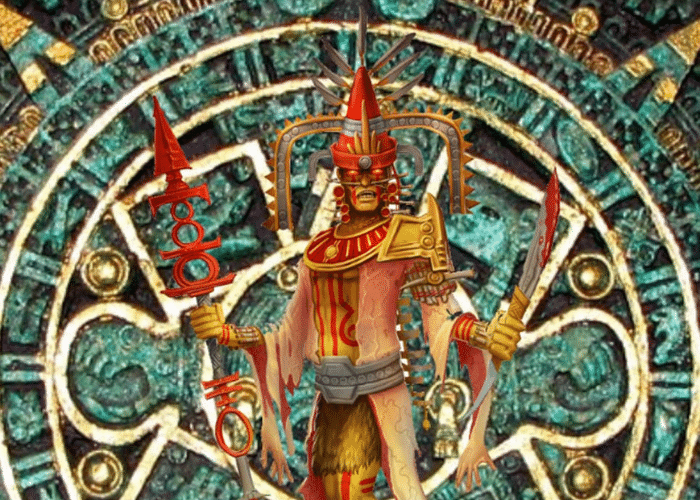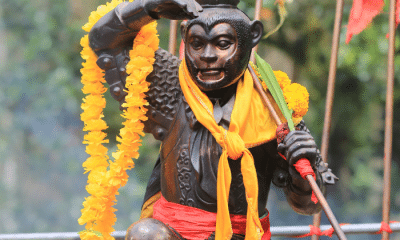
Aztec
Xipe Totec: The Flayed God
Xipe Totec: The Flayed God
The Aztec god Xipe Totec was so closely connected to the sacrifices that were offered to him that he was shown with them as his central iconography. The flayed god of Mexico wore the skin of his victims over his own body.
Aztec culture is closely associated with brutal and bloody human sacrifices.
In some instances, it is clear that tales of Aztec barbarity are greatly exaggerated. Spanish conquistadors saw the people of Mesoamerica and uncivilized and brutish, highlighting their violence while justifying colonial abuses.
Textual and archaeological evidence clearly shows, however, that these accounts were not entirely imagined. The Aztecs, among other cultures in Mesoamerica, believed that human sacrifices were necessary to appease the gods and keep their world from being destroyed.
Thus, even seemingly benign domains were associated with gruesome rituals. This is vividly shown n the character of Xipe Totec.
The god wore the diseased skin of human sacrifices over his own. More horrifying to modern thought, his priests wore the skins of recently-sacrificed men for a full twenty days to resemble their god.
Despite this, however, Xipe Totec was not a god of death or horror. He was a life-giving and benevolent deity whose festivals resembled carnivals or parades despite the constant specter of death.
Xipe Totec in Aztec Mythology
Mesoamerican people before the arrival of European powers worshiped the Flayed God under many names.
The most common was Xipe Totec (Our Lord the Flayed One). He was also known as Tezcatlipoca (The Red Smoking Mirror) and Youalahuan (The Night Drinker) in different areas.
The independent Tlaxcaltec peoples, who were never incorporated into the Aztec Empire, called him Camaxtli. A thousand years before these cultures rose to power, the Zapotec civilization worshiped a similar god that they called by the name Yopi.
Images of Xipe Totec are typically easy to identify in Mesoamerican art. His iconography is even more standardized than many of the other gods of the region and many of his attributes stand out among the other gods.
His skin is always a shade of yellow or tan, sometimes painted with half of his body in each shade. Many details of his body are shown in red, including stripes that sometimes run the length of his face as well as his hands and feet.
Xipe Totec’s eyes are generally closed but his mouth is open. He often wears a pointed cap and holds a rattle staff, both attributes of the emperor.
His right hand is usually extended and held at an upward angle. This not only holds the staff or another symbol of power, such as a bag of grain, but also highlights the god’s most unique and identifiable attribute.
Xipe Totec is not dressed in typical clothing, but in the flayed skin of a sacrificial victim. This is made clear by his hands, where the flesh of the sacrifice hands limply instead of fitting over his own.
This skin is often marked with outward symbols of death. Sometimes it is a grayish color, but it is often also covered in red blisters or pox.
Flayed skin was not only an identifying aspect of Xipe Totec in art, but written records show that it also played an important role in his worship.
Captives who were sacrificed to Xipe Totec throughout the region were carefully skinned after their deaths. The god’s priests and musicians who imitated him would wear these skins during his festivals.
There is also evidence that statues of the god may have been dressed similarly. One such statue even has a mark on its chest that corresponds to the cut used to remove a victim’s heart.
Despite the gruesome spectacle of his festivals, they were also seemingly lighthearted and frivolous affairs.
Gladiatorial matches would often be staged. These also ended in sacrifice, but provided entertainment for spectators.
The musicians who dressed as Xipe Totec also added to the festive atmosphere. They went from house to house asking for food and gifts in honor of the god.
Residents paid these musicians in alcohol and put garlands around them. The mock gods soon became inebriated, colorful spectacles.
The priests, meanwhile, took the festival more seriously. They would wear the skins of the dead for a full twenty days of rituals and prayer.
Many people believed these skins were lucky. Mothers would bring their children to touch the flesh to be cured of common ailments.
The skins of those dedicated to Xipe Totec were so priceless that they were never thrown away. Special airtight containers within the temple held the flesh of sacrificial victims for many years.
My Modern Interpretation
The mixture of gore and frivolity that characterized Xipe Totec’s rituals may seem incongruous to modern sensibilities, but to the people of pre-Columbian Mesoamerica there was a deep symbolism involved in these festivals.
Like many gods, Xipe Totec was associated with warfare. His primary role, however, was as an agricultural deity.
Xipe Totex was usually shown in shades of yellow. This was because his body represented the corn that formed the basis of the Aztec diet.
The seeds that new crops grew from existed before the planting season in a death-like form. They were dry, withered, and hard.
Before germination, however, maize shed its outer layer. Once the dead skin was removed, the seed could begin to grow and bring forth new vegetation.
This symbolic shedding also represented the annual cycle of rebirth and regrowth that was seen with the changing of seasons. Underneath a thin layer of death, the farmland that the god symbolized was ready to bring forth new life when rain made it fertile again.
When the Spanish conquistadors arrived, the main festival of Xipe Totec was held in March. The twenty days of fertility rituals that followed the initial sacrifices marked the transition from the fallow season to the time of new growth in the spring.
The sacrifices associated with Xipe Totec did more than make worshippers resemble their god. They symbolically ensured that the cycle of new life coming forth from death continued into the next growing season.
The god’s symbolism extended beyond food crops, however.
Likely because of his coloration, Xipe Totec also came to be associated with metalworkers. Goldsmiths in particular considered him to be their patron, possible because corn was a golden color as well.
The smiths performed their own sacrifices to Xipe Totec. Like the fertility rituals these involved wearing the skin of flayed men, but the victims were chosen from a different pool.
Xipe Totec’s fertility cult selected victims from war captives and slaves. The goldsmiths, however, used their religion to punish those who wronged them.
Men who stole gold were used as sacrificial victims by the goldsmiths. Before their executions, they were paraded through the streets as a warning to others.
In Summary
Xipe Totec was an Aztec god of fertility and agriculture. He was most closely associated with corn and the cycle of annual rebirth.
To symbolize this, he wore the skin of those who had been sacrificed to him. This was often marred by diseases and boils which Xipe Totec was thought to be able to cure.
Festivals dedicated to Xipe Totec incorporated this imagery in a very literal way. Both priests and celebrant musicians would wear the flayed skins of captives who had been sacrificed to appease the god.
Accounts seem to show the festivals of Xipe Totec as celebrations, however. The musicians who imitated his image drank and were festooned with garlands.
Xipe Totec and his sacrifices were thought to symbolize the rebirth that happened each spring, provided the gods were pleased. Like kernels of corn, he was shrouded in a layer of death that would be cast off when new life grew.











